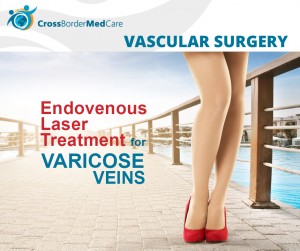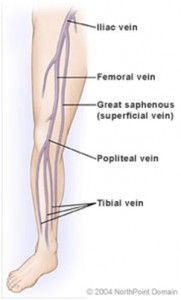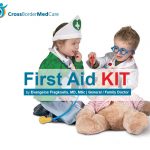Article by Konstantinos Xiromeritis MD, Vascular Surgery.
Varicose Veins
 Varicose veins are enlarged veins that often appear ropey and look blue or red. However, they also often occur deeper under your skin where you are not able to see them. People who suffer from this condition often have a family history of varicose veins. They frequently affect pregnant women and those with occupations that require long periods of standing, such as nurses and teachers.
Varicose veins are enlarged veins that often appear ropey and look blue or red. However, they also often occur deeper under your skin where you are not able to see them. People who suffer from this condition often have a family history of varicose veins. They frequently affect pregnant women and those with occupations that require long periods of standing, such as nurses and teachers.
Varicose veins are caused by unhealthy valves inside the veins. When these valves fail or leak, the blood flows backward through the poorly functioning valve. Gravity causes the blood to gather in the veins and makes them look enlarged, twisted, or full and bulging. Varicose veins are a symptom of chronic venous insufficiency, which is common as people age. They are caused by a failure in the one-way valves that prevent blood from flowing backward into the legs. The resulting backflow, called reflux, and pooling of blood can lead to enlarged (varicose) veins. They are often visible through the skin of a person’s legs as reddish or blue in color, and can cause symptoms.
Aside from their unpleasant appearance, side effects of varicose veins include pain, fatigue, itching, burning, swelling, cramping, restlessness, and throbbing. These symptoms always worsen over time.
How Can Varicose Veins Be Treated?
Endovenous Laser Treatment (sometimes referred to as EVLT) is a minimally invasive laser treatment that requires no hospitalization and no complicated surgery. The entire procedure, from start to finish, takes about an hour and there is very little or no pain. Another advantage to treating varicose veins with ELT is that most insurance plans and Medicare cover it.
For larger varicose veins, our physicians utilize ultrasound-guided sclerotherapy. The ultrasound provides a live view of your veins, allowing the physician to inject the sclerosant into the precise location for the best treatment results. Once the vein is closed, the blood that was circulating through the abnormal vein is naturally rerouted to other healthy veins. Over time, the treated vein is absorbed by the body. Varicose and spider veins can be uncomfortable and may get worse if left untreated.
Endovenous Laser Treatment (ELT, or sometimes referred to as EVLT) is a quick, minimally invasive laser treatment that requires no hospitalization and no complicated surgery. The entire procedure, from start to finish, takes about an hour and there is very little or no pain. Another advantage of treating varicose veins with ELT is that most insurance plans and Medicare cover it.
How Does ELT Work?
With ELT, a small optic fiber is inserted through a needle into the varicose vein under ultrasound guidance. The laser is activated and as the optic fiber is removed from the vein, it heats and closes the vein. Once the vein is closed, the blood that was circulating through the vein is naturally rerouted to other healthy veins. Over time, the closed vein is absorbed by the body.
Endovenous Laser Treatment (EVLT)
 Basic Facts
Basic Facts
Endovenous Laser Therapy (ELVT) is a minimally invasive procedure used to treat varicose veins.
Heat is applied to the affected areas via laser fiber, which ablates (destroys) the enlarged veins.
Although it is a newer treatment option, long-term success rates appear to be at or around 98 percent, which is as good or better than traditional surgical techniques. During Endovenous Laser Therapy (EVLT), a treatment for varicose veins, laser energy creates heat in a vein, which causes it to shrink and eventually disappear. EVLT is performed on an outpatient basis.
Pre-Treatment Guidelines
The physician will perform a physical exam and take a medical history of the patient. The physician may advise the patient to refrain from taking aspirin or blood thinners prior to the procedure. The patient should be driven to and from the procedure.
WHAT to Expect
The physician will first map all areas of reflux in the veins, using duplex ultrasound, and will determine the best place for the catheter to be inserted (usually just above or below the knee). He or she will clean, shave, and numb this area with a topical anesthetic. Once the anesthetic has taken effect, the physician will make a very small nick in the skin and insert the catheter and guide wire. More anesthetic is injected along the entire vein’s length and the guide wire is removed. Next, the laser fiber — which is a fine wire that carries electrical energy from a power generator — is passed through the catheter until it protrudes approximately 1 to 2 centimeters (.4 to .8 inches) from the end, at which point it is secured in place. The patient may be asked to wear protective glasses when lasers are in use.
Ultrasound is used to confirm the location of the catheter and laser fiber prior to therapy. The laser may be activated manually by the physician or it may be set to fire automatic pulses every 1 to 2 seconds, depending on the case. The physician will apply pressure to the skin as he or she works along the vein. The laser energy seals the faulty vein and blood flow is re-directed to healthy veins. Because the affected veins are left in place, there is minimal bleeding and bruising. EVLT is not painful, but the patient may experience momentary discomfort if the laser is fired in an area near a nerve. The physician uses ultrasonography again after the procedure, to ensure that treatment was successful. The entire process does not usually take more than 1 hour.
Post-Treatment Guidelines and Care
The patient should not drive immediately after EVLT and should refrain from lifting heavy objects, but may resume all other activities right away. The patient must wear compression stockings following the procedure, and continuously for 1 week, but can remove them for bathing after 3 days.
Konstantinos Xiromeritis
Vascular and Endovascular Surgeon- Director of Vein Disease Dept of Bioclinic Athens

 CrossBorderMedCare is a medical care provider with facilities in Sweden and Greece. CrossBorderMedCare offers a wide spectrum of health care services that meet all the needs of an international patient ranging from urgent to planned medical and dental care.
CrossBorderMedCare is a medical care provider with facilities in Sweden and Greece. CrossBorderMedCare offers a wide spectrum of health care services that meet all the needs of an international patient ranging from urgent to planned medical and dental care. 





 Athens BioClinic Hospital is a member of Bioiatriki Healthcare Group which is the largest private medical care provider in Greece. Bioiatriki Healthcare Group owns 26 fully automated primary care Diagnostic Centers and 2 hospitals in Athens and Thessaloniki serving more than 2 million people every year.
Athens BioClinic Hospital is a member of Bioiatriki Healthcare Group which is the largest private medical care provider in Greece. Bioiatriki Healthcare Group owns 26 fully automated primary care Diagnostic Centers and 2 hospitals in Athens and Thessaloniki serving more than 2 million people every year. 



